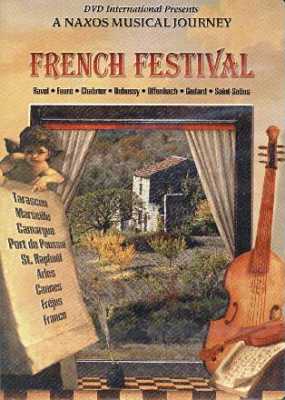Music and images is the very stuff of Film Music on
the Web (sister site of Classical Music on the Web) so it was natural
that these interesting DVDs should come under our purview. How to marry
classical music with enhancing, sympathetic visuals, has always interested
filmmakers. Just filming an orchestra in performance has limited visual
appeal so producers may be forgiven, even applauded, if they are inclined
to seek alternatives. Success – many would say a limited success – was
achieved in Disney’s Fantasia. There have also been a number
of attempts to shape documentaries to music – notably travelogues which
would seem to be naturally suitable and sympathetic because so many
pieces of music are evocations of specific places or countries e.g.
Tchaikovsky’s Italian Caprice or Borodin’s In the Steppes
of Central Asia.
In the early days of CinemaScope a short travelogue
on Italy went out with the feature Three Coins in the Fountain
(itself with a memorable score by Victor Young as well as the title
song made famous by Frank Sinatra). Remember, this was when the widescreen
system and its accompanying stereophonic sound were in their infancy,
so the travelogue was considered to be just as prestigious as the main
feature it supported. The travelogue was, suitably, about the tourist
attractions of Italy. The 20th Century Fox studio orchestra
recorded the symphonic material conducted by the studio’s main composer
and Music Director, Alfred Newman. Now Newman knew instinctively how
music could not only serve on-screen atmosphere, emotions and action
but conversely how music’s impact could be maximised by sympathetic
on-screen images. He understood that the images had to be arranged so
that their pace and dynamics and emotional atmosphere paralleled and
supported the music. (Often canny feature film directors will instruct
their editors to work to the tempo of the film’s score – e.g. see my
recent review of the 20th anniversary special DVD of Spielberg’s
E.T. on Film Music on the Web)
But to turn to the review of these new Naxos musical
journeys. First the good news, what a splendid idea! Now the bad, how
are very disappointing they both are. The DVD boxes wax eloquently that
these journeys are unforgettable. Wrong! Both journeys are too specifically
tied to relatively small areas of both France and Italy. In fact I can
imagine the Tourist Boards of both countries gnashing their teeth in
despair, for these images of not particularly attractive, off-the-beaten-track
locales are more likely to provoke yawns. In the French Festival there
are endless boring views of badly colour photographed coastlines, insipid
landscapes and uninspired buildings. In the Italian film there is again
too much emphasis on the relatively obscure Montepulciano and Contucci
vineyard districts, poorly filmed, unimaginative and with narrow-choice
views of Florence (no Cathedral interiors, no view of Santa Croce for
instance); and why a tedious journey up a funicular railway (to Luigi
Denza’s Funiculi, funiculà) just to see a row of shipyard
cranes? – surely Genoa deserves better? Not that Venice fares much better
either - just views of lesser narrow canals in winter snows (nicely
atmospheric, granted and - an unusual viewpoint of Venice) but there
is only a glimpse of a less celebrated part of the Grand Canal (no Rialto
Bridge). We do not see St Mark’s Cathedral and Square and not even a
sight of Santa Maria della Salute that regales the front of the DVD
box.
Worse, for the most part, the choice of the music is
not sympathetic to the visuals either in pace or mood. For instance,
we hear Ravel’s Pavane pour une infante défunte with pictures
of the infamous island prison off Marseilles, the Château d’If
in which ‘The Count of Monte Cristo’ and ‘The Man in the Iron Mask’
were incarcerated - a strange choice indeed. Then we hear Godard’s lovely
Berceuse accompanying pleasure boats sailing in and out of the
nondescript little fishing village and resort that is Port Camargue.
Saint-Saëns exciting Danse Macabre is set against almost
static photography of the fortress at Aigues-Mortes ("Stagnant
Water"), appropriately named in this context.
The choices for the Italian journey are disappointing,
there are far too many tarantellas (spelt tarantelle, the French
way for goodness sake!) and all the works save by Denza are by non-Italians!
Have the producers not heard of composers like Martucci and Respighi
(the Italians wrote more than just operas; and, in any case, why not
choose preludes or intermezzi?). Why could the producers not have invested
a little more time and money and taken their cameras down to Rome and
Naples. They could have used, for example, Respighi’s Pines of the Janiculum
(from his Pines of Rome) to great effect, with pictures of Janiculum
Hill in the moonlight with St Peter’s in the background.
The performances of the music are erratic and often
not very inspiring.
Lest the reader think these DVDs are a total disaster,
I would add that there are one or two tracks that nearly make the grade.
On the French Festival, beautiful night shots at Port Camargue enhance
Debussy’s Claire de lune and nicely edited film of the sea around
St Raphael on the Gulf of Fréjus match quite well Debussy’s La
terrasse des audiences au clair de lune. On the Italian Festival
Mendelssohn’s Venetian Gondolier’s Song fits the Venetian waterways
shots reasonably well and some of the more humorous stretches of Godard’s
Scènes Italiennes fit very nicely pictures of a commedia
dell’arte statue atop a campanile. But…
A wonderful concept deserving of far better treatment
than found in these dreary musical journeys.
Ian Lace
![]()

